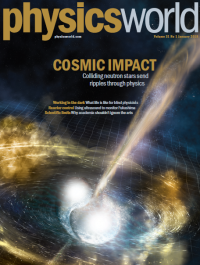Tag archives: Fermilab
See in the new year with the January 2018 issue of Physics World
Happy new year and welcome back to Physics World after our winter break. Why not get 2018 off to a great start with the January 2018 issue of Physics World, which is now out in print and digital format.
In our fantastic cover feature this month, Imre Bartos from Columbia University in New York examines the massive impact on physics that last year’s spectacular observation of colliding neutron stars will have.
Elsewhere, Bruce Drinkwater from the University of Bristol explains how he is using ultrasonics to monitor the damaged Fukushima nuclear-power plant in Japan, while science writer Jon Cartwright looks at how technology can help blind physicists.
Don’t miss either our interview with Fermilab boss Nigel Lockyer and do check out our tips for how to brush up your CV if you’re chasing a job in industry.
View all posts by this author | View this author's profile
Reminiscing about Fermilab, CAPTCHA tests your physics, science of guitar strings
By Hamish Johnston
What do huge snowstorms, pioneering childcare and bison have in common? The answer is that they all feature in video recollections of Fermilab, the particle physics facility that is celebrating its 50th anniversary this year. A playlist of the videos is available and you can watch Cindy Joe’s musings over Snowpocalypse 2011 above.
According to physics blogger ZapperZ, the online retailer Amazon is developing a new CAPTCHA technology that relies on human’s innate understanding of the laws of physics. The idea, apparently, is that a user would be presented with before and after scenarios and asked which seem plausible. This could be a ball rolling down a ramp, or a projectile flying through the air. It seems that web robots can’t solve simple mechanics problems – at least for now.
Ending on a bright note, music technologist and erstwhile physicist Jonathan Kemp of the University of St Andrew’s in Scotland claims to have invented a revolutionary type of guitar string. He riffs on his new creation in the video above.
View all posts by this author | View this author's profile
Happy birthday Fermilab
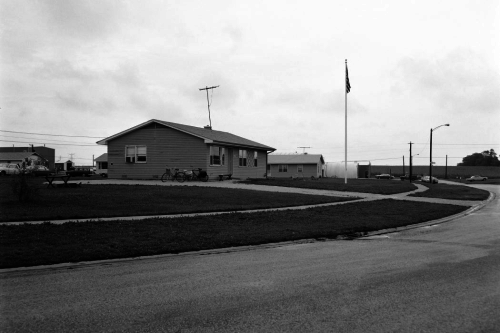
Little house on the prairie: the first director’s office on the National Accelerator Laboratory site. (Courtesy: Fermilab)
By Matin Durrani
Music lovers will remember 1967 as the year the Beatles released Sgt. Pepper’s Lonely Hearts Club Band. For sports fans it was the year when Celtic became the first British team to win football’s European Cup. As for scientists, 1967 will go down in history as the year in which the first human heart transplant took place and the first radio pulsars were detected by Jocelyn Bell Burnell, Antony Hewish and others at the University of Cambridge, UK.
View all posts by this author | View this author's profile
Send a birthday card to Fermilab, a huge periodic table, art meets quantum computing

Best wishes: a birthday card for Fermilab (Courtesy: Corinne Mucha/ Symmetry)
By Hamish Johnston and Sarah Tesh
50 years ago this month, the particle physics facility that was to become Fermilab opened its doors for the first time. To celebrate a half a century of physics on the Illinois prairie, the folks at Symmetry have produced a set of themed birthday cards that you can print-out and send to your friends and family. Indeed, there is still time to send a card to Fermilab itself, because the big day isn’t until next Thursday (15th of June). My favourite card (above) uses colliding piñatas to illustrate the plethora of particles that were produced in Fermilab’s Tevatron – which smashed together protons and antiprotons between 1983-2011.
View all posts by this author | View this author's profile
Fermilab at 50: the June 2017 issue of Physics World is now out
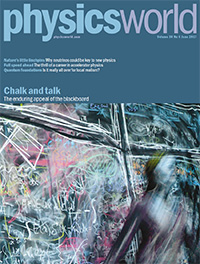 By Matin Durrani
By Matin Durrani
With America’s iconic Fermi National Accelerator Laboratory (Fermilab) celebrating its 50th anniversary this month, check out the June 2017 issue of Physics World magazine, which is now live in the Physics World app for mobile and desktop.
Fermilab mades its name with the Tevatron proton–antiproton collider but neutrinos hold the key to the lab’s future, as Ben Still from Queen Mary University of London makes clear in a feature on the physics of these elusive particles.
You can also enjoy a cracking review of Tommaso Dorigo’s new warts-and-all account of life in the CDF collaboration at Fermilab, while Seyda Ipek from the lab pops up in Philip Ball’s homage to the blackboard – which you can also read on physicsworld.com.
Plus don’t miss this month’s Lateral Thoughts, which reveals how one physicist working in a Scottish call centre ended up chatting to Enrico Fermi’s daughter-in-law about her TV.
Remember that if you’re a member of the Institute of Physics, you can read Physics World magazine every month via our digital apps for iOS, Android and Web browsers.
View all posts by this author | View this author's profile
NanoCars race on gold, sketchers invade Fermilab, physics of Thor versus the Hulk
By Sarah Tesh
Science has taken motor racing to a whole new, extremely small level with the NanoCar Race. The competition on 28 April will see nanoscale molecular machines “speed” around a gold racetrack for 38 hours. As the tiny-molecule cars are not visible to the naked eye, the race will take place inside a scanning tunnelling microscope (STM) at the Center for the Development of Materials and Structural Studies (CEMES), part of the National Center for Scientific Research (CNRS) in France. The teams behind the NanoCars control their vehicles using electric pulses but are not allowed to push them mechanically. Details about the cars and their teams can be found on this website, where you will also be able to watch the race later this month. There is more about the competition in the above video.
View all posts by this author | View this author's profile
Pokémon physics, photon torpedoes, a neutrino Ghostbuster and more
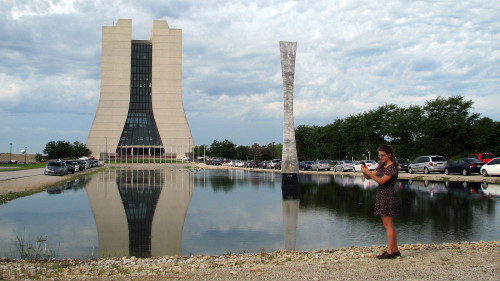
Don’t walk into the water! Pokémon Go arrives at Fermilab. (Courtesy: Lauren Biron/Fermilab)
By Michael Banks and Hamish Johnston
The smartphone app Pokémon GO has been all the rage since its recent launch. The augmented-reality game is based on the Nintendo franchise and features players exploring their surroundings while trying to catch as many of the virtual creatures as possible, According to Science, Pokémon have been spotted at a number of science centres including NASA’s Jet Propulsion Laboratory while Symmetry Magazine reports that the game has also infiltrated particle-physics labs such as Fermilab, with scientists seen walking around the lab peering into their phone as they hunt down Pokémon.
View all posts by this author | View this author's profile
Dismaland physics, laboratory photowalks and more
By James Dacey and Tushna Commissariat
While it may seem as if we Physics World journalists spend our evenings leafing through Newton’s Principia Mathematica or deriving the Dirac equation from first principles, on Wednesday night this week, a few of us visited Dismaland – the pop-up “bemusement park” curated by the elusive British street artist Banksy. Located in the seaside town of Weston-super-Mare – a few miles south-west of the Physics World Bristol HQ – Dismaland offers a darker and more politically motivated alternative to Mickey Mouse and his friends. While our visit was not work-related, there were a few unexpected physics references that we couldn’t help but spot. First we stumbled across “The Astronauts’ Caravan”, a humorous take on the flight simulators used by NASA (see video above).
Created in 2011 by artists and engineers Tim Hunkin and Andy Plant, the outwardly unimpressive-looking theme-park ride is a compact version of the Victorian “haunted swing” illusion. We won’t spoil the magic by explaining the mechanics of the ride here, but you can read this blog by Hunkin where he explains exactly how he and Plant built their spinning caravan and if you can’t visit Dismaland, then watch the video to see what it looks like from the inside.
View all posts by this author | View this author's profile
Slamming physics at Fermilab, dancing to Yuri Gagarin and lifting off from ‘Cape Kebaberal’
By Hamish Johnston
Giving a fired-up talk at a physics conference is a good way for aspiring researchers to make themselves known to the community, but unless you have a natural gift, lots of practice is required. That’s why many universities and labs host “slams” to encourage staff and students to talk about their research to a broader audience. Above is a video of the sold-out Fermilab Physics Slam 2014, which was held last week at the lab on the outskirts of Chicago.
View all posts by this author | View this author's profile
In praise of rocket scientists, ironworkers, superheroes and more
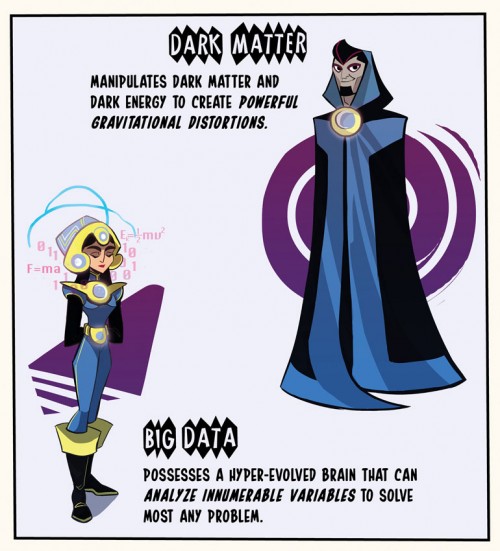
Dark Matter and Big Data are just two of the superheroes inspired by physics. (Courtesy: Brittney Williams/Symmetry magazine)
By Hamish Johnston
Q: What do you call physicists studying the electrical properties of salad greens?
A: Rocket scientists!
But that’s old news, so lettuce move on to this week’s highlights from the Red Folder…
The rocket scientists referred to in the headline are econophysicists, who got a bad rap from Warren Buffet and others during the financial crisis of 2008. Now that the great depression is nearly over, physicist and author Mark Buchanan has a much more upbeat assessment of those who have made the transition from physics to economics in his blog entry “What’s the use of ‘econo-physics’?”.
View all posts by this author | View this author's profile
